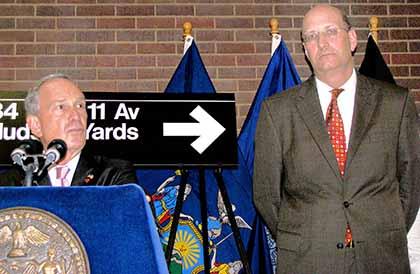By Philip Newman
Despite present financial difficulties, the MTA is building big for the future and has invited the public to follow the progress of some of the greatest changes in the transit system since its inception.
It is all on the Internet on what the Metropolitan Transportation Authority calls the Dashboard, which is crammed with figures and details about the MTA’s mega-projects.
Computer users may search the Dashboard for specific projects, like the Second Avenue subway, the East Side Access to bring the Long Island Rail Road into Grand Central Terminal and the No. 7 subway extension.
The $4.5 billion Second Avenue subway and the $7.32 billion East Side Access are due for completion in December 2016, while the $2.1 million No. 7 extension is to be finished in December 2013.
“The Dashboard provides an unprecedented level of detail and information on our capital projects,” said Jay Walder, the MTA chairman.
The MTA Capital Program runs from now through 2014.
”From station improvements to the purchase of equipment, signal improvements to updates on the Second Avenue subway, the Dashboard allows anybody to monitor the MTA’s new approach to projects designed to keep the capital program on schedule and on budget — all with a few clicks of the mouse,” Walder said.
Walder said the Dashboard will promote further transparency and reinforce the MTA’s commitment to provide information to customers that is more concise and easier to understand.
Computer users may search for a project by keyword, project category, MTA agency, project phase — planning, design, construction or completed — or by location, where an interactive map powered by Google will list projects by geographical area.
More detailed information is available by clicking on certain links.
The Dashboard can be used to check as to whether the scope of a project has changed, when it began and whether it is still on schedule and on budget.
“I believe the MTA has taken a significant step in providing MTA managers, public officials and the public itself a more user-friendly tool to track the progress, in dollars and time, of capital projects,” said MTA Inspector General Barry Kluger. “I am particularly gratified that MTA has accepted the recommendation made in our Dashboard Report to make it a more transparent and useful reporting tool to the public.”
William Henderson, executive director of the Permanent Citizens Advisory Committee, said “we believe it is a significant advance toward increasing the transparency of the MTA.”
The MTA is in dire financial straits, but capital program projects are going ahead because of heavy infusions of federal government money, which is intended for new projects and may not be used for the operating expenses of the MTA.
Reach contributing writer Philip Newman by e-mail at timesledgernews@cnglocal.com or phone at 718-260-4536.
































